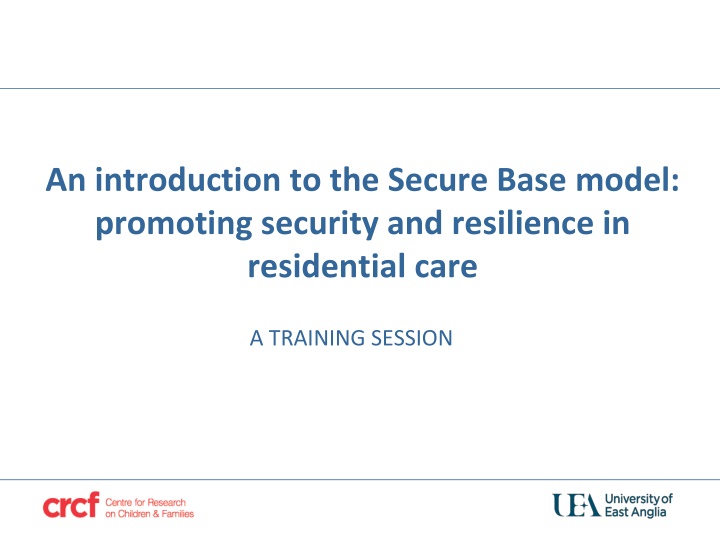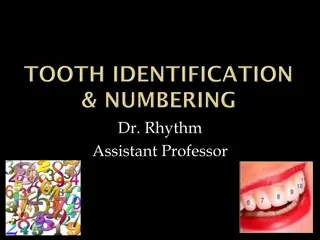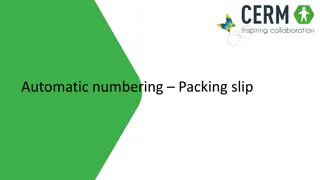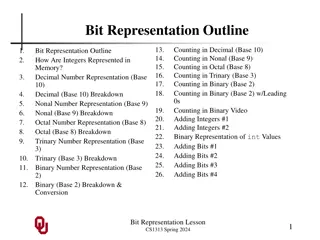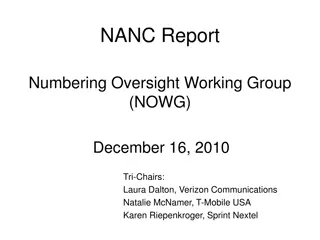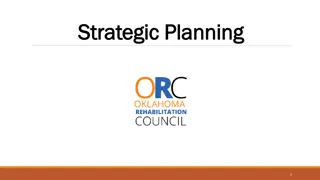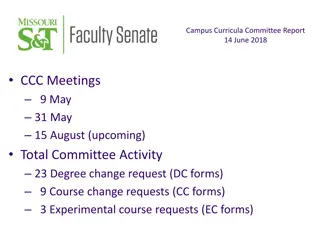Industry Numbering Committee Report to NANC
The Industry Numbering Committee (INC) addresses industry-wide issues related to North American Numbering Plan (NANP) resources. Topics include 555 Line Number Assignments, INC meetings, and closure of various numbering issues. For more details, refer to the report images provided.
Download Presentation

Please find below an Image/Link to download the presentation.
The content on the website is provided AS IS for your information and personal use only. It may not be sold, licensed, or shared on other websites without obtaining consent from the author.If you encounter any issues during the download, it is possible that the publisher has removed the file from their server.
You are allowed to download the files provided on this website for personal or commercial use, subject to the condition that they are used lawfully. All files are the property of their respective owners.
The content on the website is provided AS IS for your information and personal use only. It may not be sold, licensed, or shared on other websites without obtaining consent from the author.
E N D
Presentation Transcript
An introduction to the Secure Base model: promoting security and resilience in residential care A TRAINING SESSION
Outline of the session Theory underpinning the Secure Base model the significance of providing a secure base, security and resilience for children The Secure Base model of therapeutic caregiving Practical applications of the Secure Base model in residential care
Significance of providing a secure base for child development All infants / children /adolescents need a caregiver who provides a secure base a safe haven and comfort when they are distressed, which reduces the child s anxiety and enables the child to explore, learn and enjoy activities. This caregiving helps a child to feel secure and offers a wide range of developmental benefits in other relationships with adults and peer groups. Early relationships create the child s set of beliefs and expectations about themself and others. Secure base caregiving leads to a belief that I am loved and lovable and Caregivers can be trusted to care for me .
Significance of attachment and a secure base for young people in residential care Because of the impact of abuse, neglect and loss on development, young people in residential care will need a therapeutic, secure base everyday caregiving environment. In this supportive relationship context, there is the potential for all young people to become more secure, better able to manage their feelings and become more confident and competent at school, in activities and with friends. The young person s beliefs and expectations about themselves and others needs to change from negative to positive from I am not lovable and Other people can t be trusted to I am lovable Other people are available, understand me and can be trusted to support me .
Building resilience during childhood and adolescence - significance in residential care Key to building resilience for young people is focussing on positive relationships and constructive activity, talents and interests that build competence and confidence to approach future challenges. Building resilience and providing a secure base are linked through core concepts such as trust and self-esteem. Promoting resilience includes helping young people to understand, explore, come to terms with and resolve feelings about the past - and have a balanced and coherent story / narrative. This supports a positive identity /sense of self and helps build positive, reciprocal relationships. Life story work is relevant at all ages and stages.
EXERCISE 1 Make a list of the key people who helped you to feel more secure and confident - in your childhood and teens? And as an adult? List the qualities in these people who had such a positive impact on you.
The Secure Base caregiving dimensions that promote security and resilience Availability - helping the child to trust Sensitivity - helping the child to manage feelings Acceptance - building the child s self esteem Co-operation - helping the child to feel effective Family membership - helping the child to belong
Practice applications of the Secure Base model Assessment and working with children and caregivers/staff, Matching children and placements, including multi-agency plans for support. Caregivers / social workers setting goals for children in each Secure Base dimension and monitoring progress. The Team as a Secure Base model for supporting staff.
Why young people in residential care may lack trust Young people have often lacked consistent care and protection from reliable caregivers and have experienced moves and losses. Parents may have been unavailable through drug misuse, mental health problems, learning disabilities, their own childhood experiences - or a combination. Parents may have, for example, rejected the young person s emotional demands responded unpredictably, because of their own needs been frightening or frightened because of unresolved trauma Young people will have developed defensive strategies to cope with each kind of caregiving e.g. shutting down on feelings if rejected / becoming excessively demanding / being controlling.
Availability helping the child to trust: checklist Does the child/young person- at least sometimes: respond positively to a caregiver - seek comfort/help appropriately? use a caregiver as a secure base i.e. seek comfort, have anxiety reduced, then be confident to try new activities? trust people outside the family appropriately e.g. teachers, activity leaders, peer groups? discriminate between familiar people and strangers in seeking out / showing affection? manage friendships with peers successfully, able to trust and be trusted appropriately?
A young person lacking trust that they would be cared for or cared about The first few weeks...I was breaking out, fighting and punching the staff because I wanted to go home. I was genuinely really not liking it. My experience in my heart was I just did not want to be there...I am not proud, but it was a distressing time definitely. (Young person)
Availability- helping the child to trust Caregivers can: be there for young people physically and emotionally show this young person that they are reliable and trustworthy provide nurture/reassurance and support exploration ensure their availability is known to the young person help the young person to know that they are thinking of them when apart ensure that young people know who to turn to in their absence
Residential care relationships - availability, trust and security Young people can get a sense of security from a range of trusting relationships with individual staff members and with the staff group. These support the young person in building wider relationships at school and with friends. When care staff are off shift or on leave, young people need to know when they are going, when they will be back, that staff are thinking about them and that trusted others in the team are available for them. Staff need to be available / be a secure base for each other to reduce anxiety, promote staff well-being and maintain emotional and psychological availability for the young people.
Messages of availability from the start of the placement The key worker would go to meet them, be there for their first tea, be there on their first shift and introduce them to each person individually so that as the weeks go by, they would feel more comfortable. (Residential worker)
Holding the young person in mind when apart When you get back from holiday the key child is pleased to see you - you have brought back a little gift so you hold them in mind. You prepare them before you go and you bring them a little something, even if it s a stick of rock: I was thinking about you. I thought you might like this . (Residential worker)
Transformative experiences a young person s trust in an available staff member I loved him like a dad really, because whenever he was there he always took time out of his day to sit with me and help me. Whenever I got stressed about something he was always there for me to go and talk to. My favourite memories of me and him were we always used to love going swimming, that was my fondest memories. (Young person)
The value of wider support being available in residential care They just genuinely cared for our wellbeing. If there was ever any trouble in my life they were on to it straight away...Staff there were amazing. (Young person)
EXERCISE 2 Availability- helping the child to trust Think of a young person in your care Are there times when the young person is able to trust adults e.g. seek comfort or help with activities? Are there times when the young person has difficulty trusting adults? Why do you think this young person lacks trust? What are ways of showing availability /helping this particular young person to trust? What has worked/not worked?
Young people who find it difficult to manage their feelings and behaviour Their feelings may not have been acknowledged, named, understood or responded to in their birth families. From infancy, young people may have been overwhelmed by their feelings. Feelings and behaviour may have been misunderstood or mislabelled - in their birth families or since being in care. Feelings now cannot be expressed appropriately so they may be expressed excessively or denied, repressed, dysregulated or dissociated. Young people s feelings can sometimes be expressed through their bodies in confused ways: for example, self- harm, substance misuse, eating disorders.
Sensitivity- helping the child to manage feelings: checklist Does the child/young person - at least sometimes: express a range of positive feelings (excitement, pleasure, delight) but not get overwhelmed by them? express a range of negative feelings (anger, disappointment, sadness) but not get overwhelmed by them? communicate feelings accurately, with adult and peer group? talk about/reflect on their feelings and behaviour? talk about/reflect on the feelings and behaviour of others? have effective strategies for managing their feelings and behaviour?
Exercise 3 Sensitivity- helping the child to manage feelings My actions are completely beyond my control, like literally completely beyond my control. I can punch someone in the face and not even realise that I have done it until after I have done and no anger there just pumph and it is like Why did I do that? (Mark, age 13, came into care age 8 from a background of domestic abuse and his mother had episodes of depression. Mark has had three foster home moves.) Discuss why Mark may have had difficulties in understanding and expressing his feelings? May have become aggressive?
Sensitivity- helping the child to manage feelings Caregivers can: think about what the young person is thinking and feeling. name possible feelings and help the young person to make links to their behaviour. support the young person s emotional reflections about past, present and future- consider practical tools e.g. diary. name and model the appropriate expression and management of the caregiver s own feelings. promote empathy in the young person how do you / how might other people be thinking and feeling? Reflect together on other people feelings in daily events, books, television, films.
The value for young people of knowing their feelings are understood What helped you to change your behaviour? Key worker, home manager and deputy home manager. They have seen me every day constantly and they know what I am doing and all that lot and they know how I am feeling and they can see that I am upset or they can see that I am being really hyperactive, things like that. (Young person)
Changing behaviour through support for managing angry feelings She (key worker) helped me get most of my anger under control. By that point I was still quite angry and violent, but she was the person who helped me get control of my anger and violence...She would show me ways of relieving my stress, like there was a boxing bag. (Young person)
Tuning in to the childs thoughts and feelings- keeping the child in mind It s just a natural thing. I am the key worker for a younger child and especially during the first few months I would just be at home watching TV and I know MasterChef came on and they made spag bol and I immediately went, Oh that is her favourite dinner . And I would be walking along the street and going Oh she would really like that and so I think it is a natural thing. (Residential worker)
Keeping young people in mind when apart They come home from school and their bedroom is done and it s lovely and it s ready and waiting for them and we have been thinking about them and who is going to pick them up from school and give them that kind of early experience that they didn t have really of being loved. (Residential worker) A few weeks ago we knew that (two young people) wanted to go bowling so during the day I called up the bowling alley and booked it- and then when they came back from school, I said Oh you know I was thinking about you today and I know you like bowling so I have booked this for you while you were at school and for them that was really positive because they were like Oh thanks for thinking about us and they had a really good night. (Residential worker)
Young people with low self-esteem Many young people in residential care have experienced parenting that was negative and lacked support and encouragement. may have felt treated differently to other children in birth family - or in foster or adoptive family have experienced multiple separations within the birth family or in care that can lower self-esteem. feel profoundly worthless, so find it difficult to trust praise or manage setbacks. tend to see other people in extremes - all good or all bad. defend against feelings of worthlessness may be boastful or reluctant to compete, take risks, try new things.
Different kinds of problems with self-esteem Blaming themselves for being in care Well kind of in some way it must be my fault you know. I must have done something wrong. ...The reason why I see I went into care is because of me, because I was so naughty. (Young person) Self-esteem, but from anti-social behaviour I used to beat people up in town I really did - can t stand disrespect. My mum said, If anyone hits you, hit them back and don t listen to the authorities . (Young person)
Acceptance - building the childs self-esteem: checklist Does the child /young person - at least sometimes: show positive self-esteem think they are good at some things and able to accept not being so good at others? engage in purposeful activity that can build self-esteem? feel positive about / take pride in their appearance? feel positive about their school experiences? get involved in and enjoy activities or hobbies? manage the stresses of competing with others, academically and socially? cope with set-backs and disappointments without feeling despair?
Acceptance - building the childs self-esteem Caregivers can: accept the child /young person for who they are, strengths and difficulties find activities to do and to share, supporting achievements and enabling disappointments and setbacks to be managed. promote the idea Nobody s good at everything but everybody s good at something . model and teach the child to accept and respect different qualities and identities in self and others e.g. physical appearance, ethnicity, religion, personality, talents, sexual orientation, gender identity
Acceptance, trust and feeling at home I could just sit there and talk to him about anything and he don t judge you. (Young person) I had never had a best friend and when I was younger I used to class him (residential worker) as my best friend because every time he used to come into work he always used to like put a smile on me, because he used to put in a hundred and ten per cent effort. Like, you know, he would come in, give me a high five, give me a hug and all that and like proper make me feel like I actually was at home. (Young person)
Purposeful activities that build self-esteem I have been trying to just improve my skills...I just came off a residential camping trip for four days which was quite an experience. I did canoeing which I was terrified of, abseiling, rock climbing, obstacle course. A barbecue cook out, campfire, it was just amazing! (Young person) They was like helping me out... they did have a timetable for a weekly plan ...If I wanted an activity, if I wanted to go out, if I felt stressed they would take me out...and basically they was like a father and mother to us. (Young person)
Feeling accepted and encouraged to be ambitious for themselves At the time I had no intention of going to university, but she said, Well why don t we put it in your Pathway Plan? ... I was like fair enough. (Young person from previously disrupted school career who went on to complete a nursing degree.) Where would I be today if it weren t for them? I would probably be in jail, drugs, fighting. (Young person)
EXERCISE 4 Acceptance- building the childs self-esteem Rob (13) had come into care at the age of 7 from a background of neglect. He has ADHD and learning difficulties. A positive long-term foster care placement had ended following bereavements in the foster family and growing difficulties in managing his anti-social behaviour. He came into residential care age 12, but continued to struggle at school and with peer relationships. What could staff in the home do to show acceptance and support Rob s self-esteem? What may be the barriers (in the child or the home or the community) that make this difficult?
Young people who do not feel effective and find it hard to compromise or co-operate Many young people who come into residential care lack confidence in getting their needs met have rarely experienced co-operative parenting parents may have been too controlling and intrusive or too passive, ineffective or neglectful. have felt powerless or too powerful and controlling in birth families. have felt powerless in the care system (e.g. not feeling consulted about moves) or powerful in negative ways (e.g. intimidating foster carers, ending placements).
Co-operation- helping the young person to feel effective: checklist Does the child /young person - at least sometimes think through options and make appropriate choices? assert themselves appropriately? feel effective and competent to get their needs met? co-operate with staff and other authority figures? co-operate with peers and siblings?
Co-operation- helping the young person to feel effective Caregivers can: promote choice and autonomy within safe boundaries. help the young person to achieve results on their own, feel effective but also accept help. form a co-operative alliance with the young person - help the young person to see and experience the benefits of negotiation and compromise. promote co-operative behaviour within the group of young people and between young people and staff.
Being helped to feel effective - not giving up on you It was just, they supported you, they didn t give up on you. They made you learn who you were They help you realise that you can do things and you might act like a spoiled brat and you might not want to go to school, you might get kicked out of school, but they (staff) put your lives back on track and they sort of try and tell you, You can do that they don t give up on you. (Young person)
EXERCISE 5 Co-operation- helping the young person to be effective Jack (15) stays out later than agreed and it s not known where he has been. Consider what factors may lay behind Jack s behaviour. How might you help Jack to feel effective and be co- operative within safe boundaries?
Being supported to become more confident and competent after leaving residential care She s a lovely lady. If it weren t for her (leaving care worker)Iprobably still wouldn t be ringing up about the bills. She would ring up like the council because I wouldn t have a clue. And I would be just watching her and I am like, At least I don t have to do it . It got to the point like, No, I ll do it now, I ll do it. But she ll still come round for coffee. I don t see her as often and I don t really notice that, but I think it s because I don t need her as much. I still think she is there if I need her. If I got really stuck in the dirt, I can turn to her and just sort of say, I need help . (Young person)
Young people who do not feel they fully belong - in any family or group Young people may have felt rejected by their birth, foster or adoptive families But they may still long for a connection to those families In a residential home they may find it hard to join in with the group Young people may lack trust and resist encouragement to belong The idea of the home /staff as like a family will be valued by some young people, but rejected by others.
Family membership- helping the child to belong: checklist Does the child/young person - at least sometimes seem comfortable spending time with the staff group? seem comfortable spending time with the group of young people? seem willing/happy to be involved in group activities? enjoy special occasions with the group? have a balanced sense of identity with their peer group e.g. value their opinions but can be true to themselves? have a positive relationship with at least one birth family member? have a coherent life story for their birth family and care history?
EXERCISE 6 Family membership - helping the child to belong: Caregivers can: ensure the young person new to the home understands how the home does things. include the young person in home activities, photos etc. enable the young person to have their own space and identity. help the young person to feel valued for themselves and as part of the group develop a positive sense of belonging. enable the young person to make sense of the past, talk about / value their birth family identity and other relationships. manage contact with birth family and significant others to promote the young person s development and well-being.
